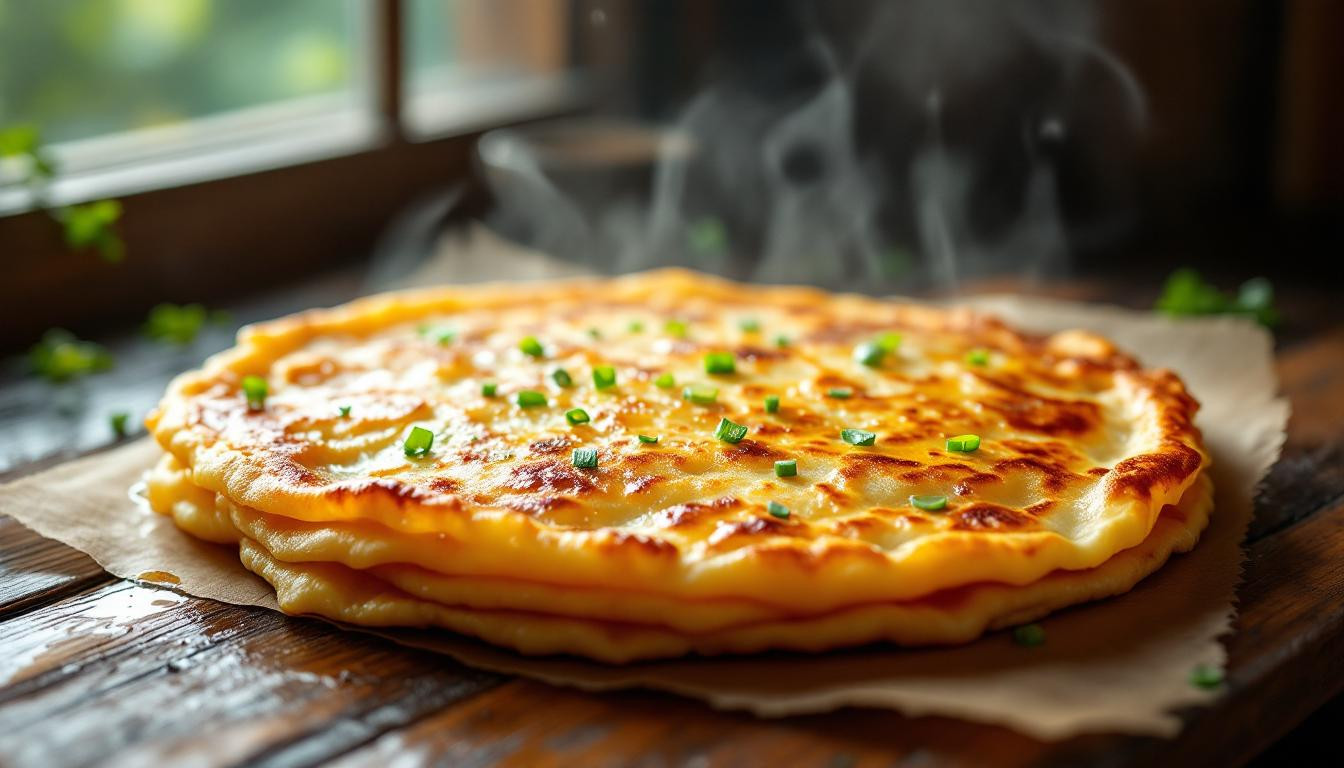I’ve always had a special place in my heart for scallion pancakes. My first experience with them wasn’t in Taiwan, but in a tiny restaurant tucked away in San Francisco’s Chinatown. The owner’s grandmother was in the kitchen, her hands moving with hypnotic precision as she rolled, folded, and fried these incredible crispy-yet-chewy discs of heaven. Years later, after traveling throughout Taiwan, I learned that the secret to authentic Cong You Bing lies not just in the ingredients, but in understanding the crucial lamination technique that creates those beautiful, flaky layers. 🥟
The Art of Taiwanese Scallion Pancakes 📖
Scallion pancakes originated in northern China but have become a beloved street food staple throughout Taiwan. Unlike Western pancakes, these aren’t made with a batter – they’re crafted through a special dough-folding technique that creates distinct layers, similar to a croissant but with a completely different texture and flavor profile. What makes the Taiwanese version special is its emphasis on achieving the perfect balance between crispy exterior and chewy interior. 🇹🇼
Essential Ingredients 🧾
For the dough:
- 2 cups (250g) all-purpose flour
- ⅔ cup (160g) boiling water
- 1 tablespoon neutral oil (vegetable or peanut)
For the aromatic filling:
- 2 tablespoons traditional lard (or coconut oil for a vegan option)
- 2 tablespoons all-purpose flour
- ¼ teaspoon salt
- ¼ teaspoon ground Sichuan pepper (or five-spice powder)
- ½ cup (40g) finely chopped scallions (mostly green parts)
- 2-3 tablespoons neutral oil for frying
Chef’s Note: The boiling water technique is crucial here – it partially cooks the starches in the flour, creating that distinctive chewy texture that makes authentic scallion pancakes so special. This is what my Taiwanese colleagues call “hot water dough” (烫面), and it’s non-negotiable for authentic results! 🔥
Crafting Perfect Layers 📝
1. Begin by mixing your flour with boiling water using chopsticks until loosely combined. Knead on a lightly oiled surface until smooth, about 3-4 minutes. Cover with plastic wrap and allow to rest for 15 minutes – this relaxes the gluten and makes the dough more pliable. ⏲️
2. While the dough rests, prepare your flavor paste by mixing lard (or coconut oil), flour, salt, and Sichuan pepper until smooth. This paste is our flavor vehicle and crucial for creating those flaky layers we’re after. 🌶️
3. Roll your rested dough into a thin rectangle (approximately 17″ × 13″). Brush your fat paste evenly across the surface – be generous but avoid globs that could tear the dough during rolling. 🧈
4. Sprinkle your scallions evenly across the surface. The aromatics should be distributed uniformly for consistent flavor in every bite. 🧅
5. Now for the critical technique: roll the dough tightly from the short end into a log shape, then cut into four equal pieces. These will become your individual pancakes. Roll each cylinder into a ball, then gently flatten into 5-6″ discs. Let these rest for 5 more minutes before cooking. 🔄
The Art of the Fry 🍳
1. Heat 2-3 tablespoons of oil in a non-stick pan over medium-high heat until shimmering but not smoking. You want the oil hot enough to create an immediate sizzle. 🔥
2. Add your pancake and immediately reduce heat to medium. This initial high heat creates that golden exterior while the reduced temperature allows the layers to cook through without burning. Fry for about 5 minutes per side, pressing gently with a spatula to ensure even contact with the pan. 👨🍳
3. The perfect scallion pancake should have a golden-brown, crispy exterior with visible, flaky layers when you tear into it. Drain briefly on paper towels and serve immediately – these pancakes wait for no one! ⚡
Serving Traditions 🍽️
In Taiwan, scallion pancakes are often enjoyed with a simple dipping sauce of soy sauce, rice vinegar, and a touch of sugar, perhaps with some grated ginger or additional scallions. They make a wonderful accompaniment to vibrant tomato-based soups or can be paired with hearty stews for a complete meal. Looking for another dough-based treat? Try my Turkish flatbreads or cloud-like scones!
The beauty of mastering scallion pancakes is that once you understand the technique, you can experiment with fillings like sesame seeds, different herbs, or even cheese for a fusion approach. But I encourage you to try this traditional recipe first – there’s a reason these humble pancakes have endured for centuries. When you pull apart those crispy, flaky layers and see the steam escape, carrying the aroma of scallions and toasted dough, you’ll understand why they remain one of the world’s most beloved street foods. As my Taiwanese mentor chef once told me, “The hands remember what the mind forgets” – so get in there and start folding! Your hands will learn the way. 💫
